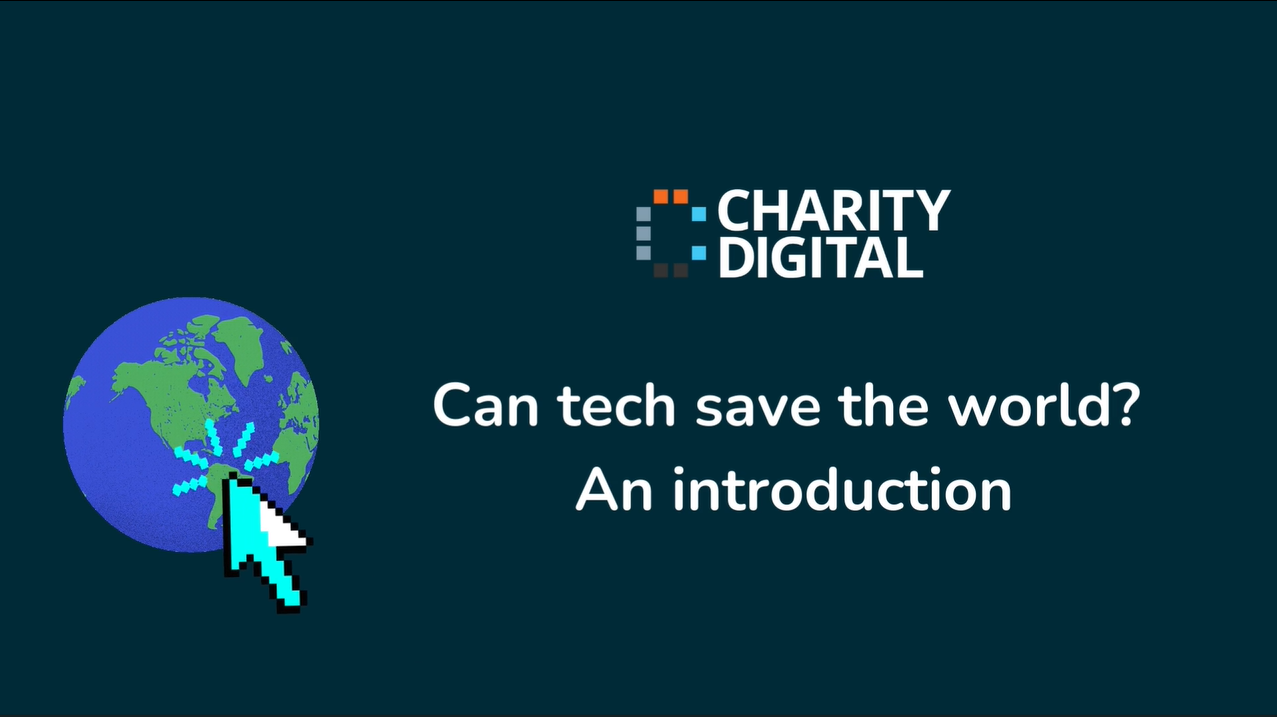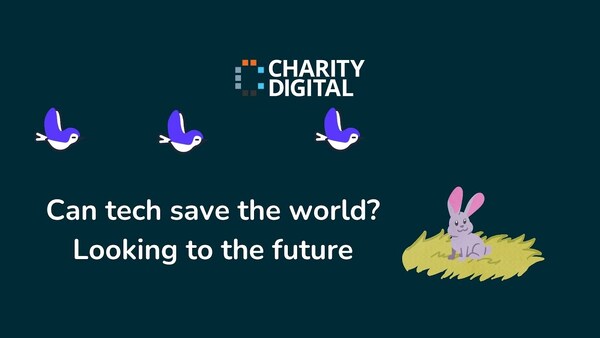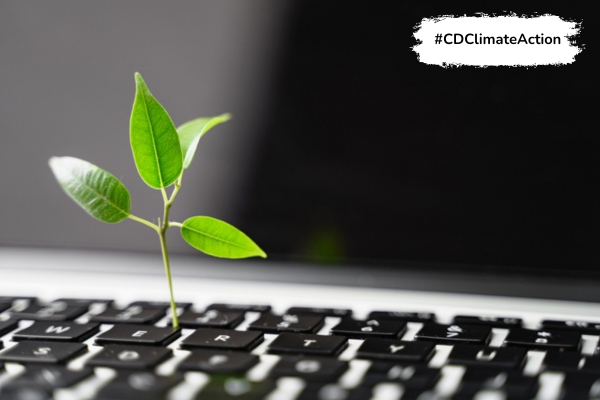Insights
INSIGHTS
All Topics
My Account
Climate change: Fifteen green ideas for 2024
We define sustainability and the outline key steps charities can take to react to the climate crisis through leadership, operations, culture, and finance
Check out the ’Climate Action’ Hub!
As a sector, we care about climate change. Our 2023 report, ‘Climate Change and the UK Charity Sector’ found that 86% of charity professionals say environmental sustainability is a personal priority for them. But it also found that we haven’t yet succeeded in translating these values into our work, with only 52% saying it was a priority for their organisation.
To address this, we have put together a guide to becoming a more sustainable organisation, outlining some of the most impactful actions you can take to help turn the corner on climate change, contributing to a better world for your charity’s service users and beyond.
Skip to: What is the definition of sustainability?
Skip to: How to be more sustainable through leadership and governance
Skip to: How to be more sustainable in your day-to-day work
Skip to: How to have a more sustainable culture
Skip to: How to make finances more environmentally sustainable
What is sustainability?
Sustainability is defined by the United Nations (U.N.) as “meeting the needs of the present without compromising the ability of future generations to meet their own needs”. They say: “The survival of our societies and our shared planet depends on a more sustainable world”.
The Stockholm Resilience Centre’s Planetary Boundaries framework is used to visualise the nine processes that regulate the stability and resilience of the Earth system. Operating within these boundaries will allow humanity to continue to develop and thrive for years to come, whereas crossing them increases the risk of generating “large-scale abrupt or irreversible environmental changes”.
In 2015, all member states of the U.N. adopted 17 Sustainable Development Goals (S.D.G.s). These are a blueprint intended to achieve a better and more sustainable future for all. Examples of the goals are “No Poverty”, “Reduced Inequalities”, “Responsible Consumption and Production”, and “Climate Action”. The goals are all interconnected and the U.N. stresses that they must all be achieved by 2030 in order to leave no one behind.
At the halfway point to the goal deadline, the 2023 assessment of progress towards the S.D.G. targets shows that 15% are on track, while 48% are moderately or severely off track, and 37% have stagnated or regressed. Find out more about the goals’ current status here.
The U.N. says: “It is not only up to our world leaders. Every person can benefit from a more prosperous, inclusive, and resilient world. We can all do something about it, regardless of whether we are in a government or civil society, run a business or home, are in school, or out of it.”
Action will look different to every organisation, and indeed every person. The charity sector can take inspiration from other sectors but also use its own unique qualities to make an impact. Below, we explore how.
How to be an eco-friendly leader
Look at the bigger picture
In the U.K., many of the purposes a charity can have also align with the Sustainable Development Goals (S.D.G.s). In 2017, 39% of U.K. charities were found to use the goals within their strategy.
Sonja Graham, managing partner at Global Action Plan, explains that embracing the goals could mean working in more interconnected and collaborative way with other organisations; relate charities’ work to the bigger global picture for the benefit of charity staff, beneficiaries, and funders; and give charities a framework to become more innovative with their own missions.
The Canadian non-profit Support Black Charities says: “Nonprofit organisations play a vital role in advancing the S.D.Gs. With their agility, grassroots connections, and community-focused approach, nonprofits are uniquely positioned to drive change at the local level. These organisations work tirelessly to address societal challenges, mobilise resources, raise awareness, and implement sustainable solutions”.
So charity leadership teams can use the S.D.G.s to identify where their work is already contributing to global sustainability, and understand opportunities to push impact even further to address not only their core mission, but also the shared global challenge of climate change.
Understand the risks of climate change
Our report found that 71% of U.K. charity professionals think the impacts of climate change has affected their charity in the past or will do in the future. Indeed, climate change can pose risks to both charitable organisations and their stakeholders.
In terms of service delivery, the U.N. describes climate change as a “risk multiplier”, meaning that it worsens existing challenges, from physical and mental health to international peace and security.
Risks to charitable organisations themselves might include a change in the location of service demand, risks to staff, the risk of falling foul of environmental regulation, and risks to public perception and therefore donations.
In Kind Direct’s Environmental Policy exemplifies questions that charity leaders and trustees can ask to review the impact of climate change upon its communities and supply chain:
- How will the charity’s purpose and values intersect with environmental issues?
- How will beneficiaries be affected?
- Where is there opportunity to collaborate and support environmental action?
- How can the charity embed climate actions in its strategy, business planning, and organisational goals?
The charity’s environmental policy also outlines questions that pertain to long-term planning and risk reduction, which are discussed with their Finance and Governance Committee.
When looking at reputational risks, it is also a good idea to make sure your claims and activities steer clear of greenwashing: when brands make green claims, for example on their products or policies, that make them appear to be environmentally friendly when their actions are often contradictory.
Communicate and demonstrate sustainable values
When looking at how people perceived the priorities of their charities’ leadership teams, our report found a telling discrepancy: 66% of respondents in leadership roles said it was a priority, but only 56% over all roles said the same. This is likely due to a lack of communication from the top: 54% of respondents responded either “No” (38%) or “Not sure” (16%) when asked if their charity’s leadership team regularly talks about sustainability.
According to the Stanford Social Innovation Review, leaders play a key role in setting the tone for their team to become more environmentally sustainable. This is due to the fact employees and other stakeholders are often sceptical about a company’s motivations for getting involved in sustainability initiatives: “leaders’ actions speak louder than words and play a huge role in signalling company values to employees”.
That 86% of charity professionals say environmental sustainability is a personal priority for them, but only 52% say it is a priority for their organisation is also worth noting in the context of conscious quitting. Dr. Curtis Odem, Associate Professor of Management at Northeastern University, says, “When a company’s values are aligned with its purpose, employees experience increased engagement, loyalty, and job satisfaction”. Embracing environmental sustainability could therefore greatly assist the 46% of nonprofits who planned to shift their resources and priorities to retaining staff in 2023.
Embed sustainability into decision-making
In our report, we found that only 54% of charities factor sustainability into their decision-making. To do so on an over-arching level, leaders can write an environmental strategy.
The aim for leaders should be to integrate sustainability into the decision-making process at every stage and level. According to the Cambridge Institute for Sustainability Leadership, “This can require them to build awareness and understanding, to achieve alignment around a clear purpose and strategy, to instil a sense of responsibility and agency, and to address critical capability gaps.”
Embedding sustainability into decision-making also means empowering the charity’s team to make well-informed and appropriate decisions on sustainability. In 2023, only 61% of charity professionals state that they feel empowered to make sustainable improvements within their organisation. This is compared to 80% of employees who reportedly want to contribute to their organisation’s climate or Environmental, Social, and Governance (E.S.G.) goals.
Yogesh Chauhan, Director of E.S.G. for HubSpot, recommends equipping employees with knowledge and tools to contribute to sustainability goals, being transparent about sustainability efforts, and collaborating across teams to encourage sustainable behaviour at all levels.
Write an environmental policy
To communicate your charity’s commitments, write an environmental policy for both internal and external use. While staff and volunteers can use the document as a guide to operating sustainably, external stakeholders such as beneficiaries, donors, and the public can use it to see what you are doing to combat climate change in how you work.
The infrastructure charity In Kind Direct share their policy with staff during induction, as part of regular policy presentations at staff meetings, and when shaping new projects or initiatives. A link to their full environmental policy can also be found by external stakeholders on their public-facing website.
In their research into the challenges facing charity trustees, Charities Aid Foundation comment on the state of affairs: “A minority of charities have a clear, official sustainability policy. These tend to be larger charities – reflecting perhaps both increased pressure from employees to create sustainable policies and an understanding that incorporating sustainability into a charity’s functioning is viewed favourably, especially if the charity is well-known. Developing a sustainability policy can effectively be seen as a form of reputational management and safeguarding.”
You can check out examples of environmental policies and statements in our climate resource bank for charities. Our interview podcast “How to create an environmental policy” is another useful resource.
How to be more sustainable in your day-to-day work
Look at overall impact
Different charities will have different opportunities and priorities when it comes to improving the environmental sustainability of their operations. Key areas to think about are energy consumption, water usage, waste, carbon footprint, and supply chains. Here are some useful resources to help you calculate, understand, and improve the overall environmental impact of your operations:
- 360Carbon – Free carbon footprint calculator
- S.M.E. Carbon Calculator
- The MacKay Carbon Calculator / My2050
- Greenhouse Gas Protocol – Calculation Tools
- Edinburgh Science – The Net Zero Toolkit
- S.M.E. Climate Fit – Free training on how to cut your emissions
Make your workplace eco-friendly
If your charity has a physical office, there are a number of things you can do to improve its sustainability. The global environmental charity World Wildlife Fund (W.W.F.) recommends switching to renewable energy; developing a sustainable procurement policy; using deforestation-free paper; remembering the waste hierarchy; choosing products that are built to last, repairable, and recycled; and using office plants.
Use digital technology sustainably
Digital technology can be both part of the problem and part of the solution to climate change – it just depends on how humans choose to use it. The carbon footprint of our gadgets, the internet, and the systems supporting them account for around 3.7% of global emissions – similar to the amount produced by the airline industry globally.
One key step you can take to reduce the environmental impact of your digital tech is making sure to recycle any old technology. This could be through an electrical retailer buy-back scheme, council recycling, or donation.
Another way is to only purchase refurbished tech. This can actually save your charity money as well as helping to save the planet. Here we list the companies, charities, and other organisations offering refurbished tech.
Some other ways charities can use digital tech sustainably are using video calls rather than travelling to a shared location, storing data on the cloud, and digitising backlog projects. Perhaps unexpectedly, you can even make your website greener!
You could go paperless as an organisation, for example by using digital signatures. W.W.F. suggests using initiatives such as “setting the default on printers to printing black and white, and double-sided, or even for more of a challenge try setting a maximum sheets-per-person printing target”.
In general, it’s good to get informed of the environmental cost of your digital activities, and act accordingly. For example, did you know that while a regular email is responsible for 4g of carbon dioxide emissions, an email with a photo or hefty attachment is responsible for 50g?
Here is a quick guide to calculating and reducing your digital carbon footprint, and here we outline how to make the argument for green technology in the workplace.
Set and deliver environmental targets
Setting targets can help focus you and your team in building towards a more sustainable organisation. To go “net zero” means to “reduce greenhouse gas emissions and/or to ensure that any ongoing emissions are balanced by removals”.
The U.K. Department for Environment, Food, and Rural Affairs explains the benefits of measuring your organisation’s greenhouse gas emissions are that it helps with saving money, becoming more competitive, meeting the information needs of customers, and doing your bit.
Their guidance outlines the steps for small businesses to measure and report greenhouse gas emissions, and is also applicable to charities. Meanwhile, the Charity Finance Group provides guidance on building a net zero strategy.
Alternatively, Carbon Neutral Britain is a non-profit that calculates, helps to reduce, and offsets organisations’ carbon footprints.
A net zero strategy can bring significant financial benefits to a charity, such as maximised efficiencies through reduced, energy, waste, and water costs; and increased appeal to donors and funders.
Charities who have committed to net zero include Marie Curie, St John Ambulance, and Bridge House Estates. The science education charity Edinburgh Science has set a number of carbon reduction targets which might also serve as inspiration.
W.W.F. says: “You can also set targets that aren’t emissions-based, such as reducing energy or water use by 2% a year. Set ambitious but achievable targets and report against these publicly on your website. This shows dedication to the environment, responsibility for your impacts, and that you’re willing to be held accountable to your stakeholders.”
The Small Medium Enterprise Climate Hub outlines the financial support that businesses can get for reducing their emissions, including from customers, banks, grants and other forms of government support, and balance sheet and investors. These may also be useful for charities.
How to have a green culture
Speak up about sustainability
Our report found that in 2023, only 61% of charity professionals feel empowered to implement environmentally sustainable improvements within their charity, with those working in service delivery and operations feeling the least empowered (73%).
As we have previously explored, charity leaders play a key role in leading on values and embedding sustainability into decision-making processes across the organisation.
However, as explained by the job website Indeed, “innovation and a healthy work environment often rely on the ideas, regular brainstorming, and feedback of employees”. They recommend being respectful about timing, using active listening, starting by asking questions, preparing in advance, and delivering what you have to say with confidence.
For example, if you see an opportunity for your charity to improve its environmental impact (especially if it’s easy), you can let the relevant stakeholders know. We found that 86% of charity professionals personally prioritise sustainability, and that 94% think the charity sector has an obligation to address climate change – so this may be more welcome than you expect!
More generally, talking about climate change with the people around us can help us personally grapple with the challenges at hand and even drive wider change. Climate Outreach’s ‘Talking climate handbook – how to have a climate change conversation’ and ‘Britain Talks Climate’ toolkit are a great resources to help with this.
Involve Human Resources
As seen by the E.S.G. movement, environmental issues are interlinked with the social and governance elements of organisations. For this reason, human resources (H.R.) has a natural role to play in developing an environmentally sustainable culture in any organisation.
H.R. can integrate environmental sustainability into recruitment processes, for example feeding back to charity leaders about the suitability of current sustainability policies in attracting potential recruits. They can also screen new applicants for positive green beliefs and include green training in their onboarding processes.
With established staff members, the H.R. team can design work tasks to meet organisational green policy requirements and provide employees with green training and educational opportunities. Research also suggests that organisations should properly appraise green employee behaviour, linking it to promotional opportunities, pay, and compensation.
Perhaps H.R. could conduct a survey around environmental accountability and appetite in the organisation, reconsider your H.R. and training suppliers, or review whether staff travel could be reduced.
Marie Curie’s Sustainability Manager Amy Moore also suggests that charities provide posters or screensaver graphics to remind staff how to save energy. Key points of individual action such as how to purchase sustainably for the office, reminders to switch off monitors when not in use, and the use of recycling facilities could be highlighted to charity teams in this way.
The H.R. consultancy firm Jaluch H.R. and Training summarises: “just make sure you are getting stuck right in, for the time of H.R. sitting on the sidelines is long gone!”
Set up a sustainability steering group
This step will be executed differently depending on the size of your organisation and where it is on its sustainability journey.
To form a Green Team, the sustainability consultancy Cultivating Capital recommends asking for internal volunteers with a view to gaining representation throughout the organisation. To get started, the team could identify and work towards solving quick sustainability wins in the charity, organise green learning sessions for the wider team, and set up more sustainable purchasing policies. Marie Curie’s Environment and Sustainability Steering Group works to a Carbon Management Plan to decarbonise all areas of the organisation.
Make it fun
Finding ways to make green projects, activities, and initiatives fulfilling and fun can create a sense of creativity and teamwork. This could include incorporating sustainability into team-building days, for example a green scavenger hunt, trivia event, or art project. If your culture involves gifting Secret Santas at Christmas, how about encouraging the team to source their surprises second-hand from charity shops?
How to make finances more environmentally sustainable
Embrace green pensions
Pensions can be a way of investing in a better world. The campaign Make My Money Matter is calling for “all organisations to have a green pension that helps save for their employees’ future and build a better world for us all”.
The campaign states, “Without realising it, your pension scheme might be undermining the critical steps you’re taking through your sustainability strategies.”
The campaign’s Green Pensions Guide outlines four key characteristics of a green approach to pensions investments. These are:
- Going net zero across the entire portfolio of pension assets, including a halving of emissions by 2030
- Pension investments into climate change solutions, such as biodiversity, clean energy, and regenerative farming
- Active engagement with investee companies to push them to reduce emissions
- Controlled divestment from those companies or industries that have no intention to reduce their high emissions, such as coal
Sir David Attenborough comments: “It is crazy that our banks and our pensions are investing in fossil fuels, when these are the very things that are jeopardising the future we are saving for.” Charitable organisations such as Oxfam, Save the Children, and W.W.F. have also signed up to Make My Money Matter’s Green Pensions Charter.
Employees can also tell their existing pension providers go green via email.
Make other investments sustainable
Beyond pensions, charities are allowed to make other investments, so long as they further their charitable purposes. Trustees are ultimately responsible for making sure these investments are legal and in the best interests of the charity.
It is worth noting that, as seen in Butler-Sloss v The Charity Commission, trustees have discretion over whether to exclude investments which they reasonably believe are in conflict with their charity’s purposes. You can also check out the Charity Commission’s investment guidance to all charities here.
Carbon Collective define green investing as the practice of allocating funds towards investments that prioritise environmental sustainability, social responsibility, and good corporate governance. They state, “Green investing has the potential to deliver competitive financial returns while contributing to a sustainable future.”
“By establishing clear financial goals, conducting thorough research, and working with experienced professionals, investors can achieve their objectives while making a positive impact on the world.”
The Intergovernmental Panel on Climate Change has identified increasing investments to climate investments as “important” to achieving the climate goals.
On the other side of the coin is divestment: moving your money away from areas of the economy that are unethical. The National Council for Voluntary Organisations (N.C.V.O) has launched a campaign to encourage charities to consider divesting in fossil fuels. Their fossil-free investment agreement involves three steps:
- Confirm no investments in fossil fuels
- Acknowledge the impact of climate change
- Support growing voluntary sector commitment
You can commit to either divesting away from fossil fuels, or to following the above agreement, on the N.C.V.O. website.
Sign up for our newsletter
Click above to receive the latest sustainability content straight to your inbox
More on this topic
Related Content
Recommended Products
Recommended Products
Our Events
Charity Digital Academy
Our courses aim, in just three hours, to enhance soft skills and hard skills, boost your knowledge of finance and artificial intelligence, and supercharge your digital capabilities. Check out some of the incredible options by clicking here.

























